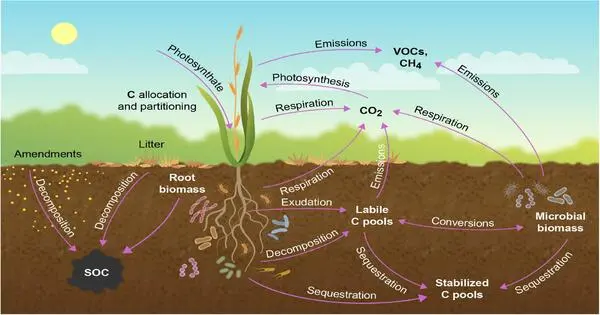Soil carbon is the organic carbon found in the soil, primarily in the form of decomposed plant and animal wastes. Solid carbon is stored in worldwide soils. This comprises both soil organic matter and inorganic carbon as carbonate minerals. It is critical to the soil’s ability in our ecosystem. It is an important component of soil organic matter, influencing soil fertility, structure, and overall health.
Soil carbon plays a critical role in the carbon cycle, impacting both terrestrial and atmospheric carbon levels. It functions as a carbon sink in the global carbon cycle, contributing to biogeochemistry, climate change mitigation, and the development of global climate models. Natural variations, such as organisms and time, have had an impact on soil carbon management. The main influence has been human activities, which have resulted in a large loss of soil organic carbon. Human activity includes fire, which removes the top layer of soil and exposes the soil to extreme oxidation.
There are two main forms of soil carbon:
- Labile or Active Carbon: This is the easily decomposable fraction of soil carbon, consisting of fresh organic materials in various stages of decomposition. Labile carbon is readily available for microbial activity and nutrient cycling.
- Stable Carbon: This fraction consists of more resistant organic matter, such as humus, which has undergone advanced stages of decomposition. Stable carbon has a longer residence time in the soil and contributes to long-term soil fertility and structure.
The amount of soil carbon in an ecosystem is influenced by various factors, including climate, vegetation, land use practices, and soil management. Human activities, such as deforestation, agricultural practices, and land-use changes, can significantly impact soil carbon levels.
Soil carbon has several important functions:
- Nutrient Cycling: It serves as a reservoir for essential nutrients, such as nitrogen, phosphorus, and sulfur, playing a crucial role in nutrient cycling within ecosystems.
- Water Retention: Soil organic matter, including carbon, improves soil structure and water-holding capacity, helping in water retention and reducing the risk of erosion.
- Climate Regulation: Soil carbon is a significant component of the global carbon cycle. Changes in soil carbon stocks can affect atmospheric carbon dioxide levels, influencing climate dynamics.
- Biological Activity: Soil carbon supports a diverse range of microbial communities and other soil organisms. Microbes decompose organic matter, releasing nutrients for plant uptake.
The management of soil carbon is gaining attention as a potential strategy for mitigating climate change. Practices such as cover cropping, agroforestry, conservation tillage, and organic farming can enhance soil carbon sequestration, helping to offset carbon dioxide emissions from human activities.














